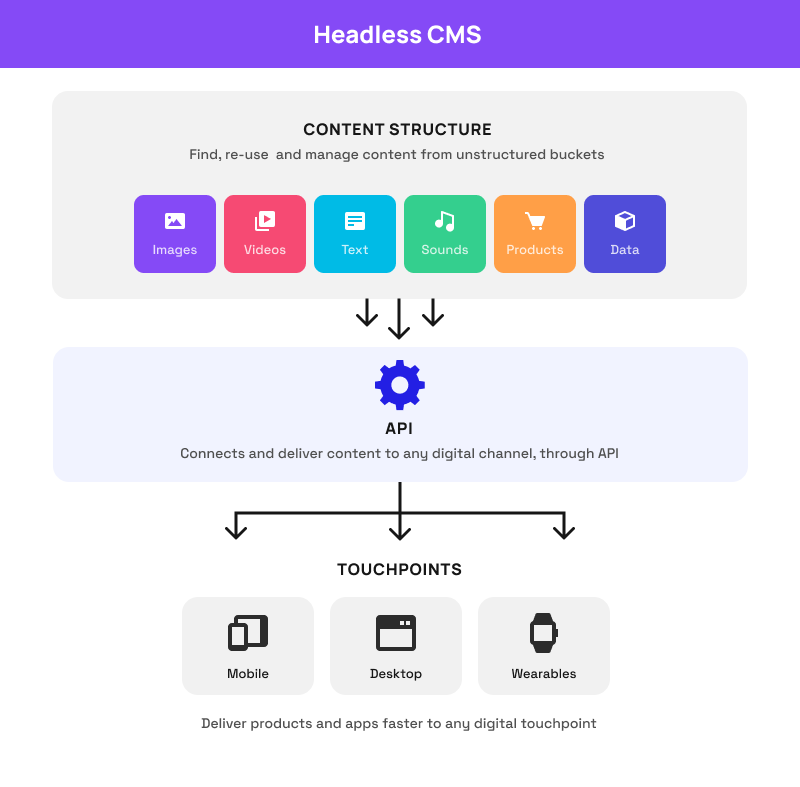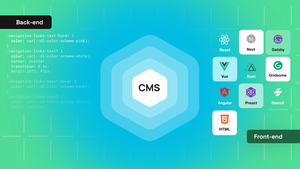If you've been creating content for the internet, particularly marketing content, then there's a good chance you've come across CMS solutions. What you may be less familiar with, however, are the new shapes and sizes that CMS solutions come in.
Over the years, the CMS model has advanced substantially, so much so that it can feel completely foreign to marketers and developers alike.
In this post, we're going to look at the types, pros, and cons of various models of CMS for developers to know about — including the headless CMS front end.
Start building dynamic websites
Connect your Teleport project with a Headless CMS like Strapi, Contentful, Caisy, Flotiq or Wordpress. Manage the frontend visually with Teleport, using dynamic data from a CMS.
Build your first dynamic websiteWhat is a CMS?
Let's start with what a CMS is. For those that don't know, a CMS is a Content Management System. As it sounds, this is a tool for managing content, and generally large amounts of it.
WordPress is the most popular and familiar CMS. It has a CMS front end that displays your content as a blog or article, and it has a back end where you create and manage that content. What’s more, WordPress turns the technical back end (where keywords, metadata, and HTML live) into readable content nearly automatically.
In addition to acting as the bridge between the front end and back end of your content, CMS services also store and organize your content. You can create thousands of pieces of content, and your CMS will still store, sort, and host all of them.
Why is a CMS important for developers and marketers?
CMS solutions are important particularly to marketers and developers. For marketers, they provide a fast and effective tool for deploying content. Creating, formatting, storing, and displaying content is all done in a manner that is fast and effective.
For developers, CMS systems do a lot of the heavy lifting. There is still some front-end development that will need to be done occasionally, especially when it comes to keeping a CMS website looking modern and branded.
On a daily basis, though, the CMS will be handling menial tasks that would otherwise have to be done manually. Even something as simple as posting a blog to a CMS would require creating a new page of the website, which would eat up developers' time.
The three types of CMS
While this list is likely to expand over time, for now, there are just three main types of CMS. We've mostly been talking from a traditional CMS perspective, but as we move forward, we'll start to focus on what we're confident is the future of CMS.
Traditional CMS
As mentioned, traditional CMS platforms are what we've mostly been talking about so far. Traditional CMS solutions are ones that are "coupled", meaning that the front end and back end are inseparable.
Or, put another way, the CMS acts as a bridge between the two. It takes your content and its associated data then publishes it to the web and your website. This saves you a lot of time and energy.
But it's also a bit limiting. That's because your content is more or less tied to that CMS. You can't post it to another website, reuse it easily, or update it without manually going back and changing details to each piece of content.
Decoupled front end CMS
While the traditional CMS formula has been the go-to for businesses for decades, we're beginning to see substantial innovation in this department. That mostly has to do with the switch to omnichannel marketing, where businesses are marketing content across a variety of channels rather than simply through a blog.
Since traditional CMS systems aren't very good at omnichannel marketing, developers created decoupled systems. In this setup, the CMS isn't a bridge between the back end and front end. Instead, content is created in the back end and then sent out over the front end.
That pathway looks like this: You create a piece of content, then hit publish. It's intercepted by an API, which publishes it to channels like social media and different websites, before finally sending it to your front end, where it's published like a normal blog.
Headless front end CMS
Decoupled CMS and headless CMS solutions are similar. So similar, in fact, that you're likely to hear these terms used interchangeably. Like decoupled systems, a headless front end is designed to address the growing importance of omnichannel marketing.
Where they differ, however, is in their path. While a decoupled CMS will send out your content to different channels before publishing it, a headless CMS stops after sending it out to different channels.
That's because it's headless — it leaves the formatting and publishing up to the channels it sends it to. This allows each channel to handle the content in whichever way is best for it.\

The benefits of headless front end development for CMS
Each type of CMS has its benefits, but in our mind, headless CMS solutions are the best currently available. And to illustrate why exactly, here's a breakdown of some of the key benefits you get when you invest in headless.
Next-level omnichannel experiences
First, headless CMS solutions provide next-level omnichannel experiences. Unlike traditional CMS services, which were created before omnichannel really took off, and decoupled CMS services, where omnichannel is just a feature, headless CMS was built on the idea that omnichannel is the way forward.
For many of us, this is something we already know intuitively. People interact with a variety of channels, including email, blogs, customer service, product pages, social media, and more.
Meeting them where they are requires delivering content across a variety of mediums and channels. That's precisely what headless CMS does. It allows you to create your content once and then have it posted to any and all channels that you desire.
Gives developers more freedom
Another benefit of headless CMS is that it provides developers with the utmost freedom. That's because they aren't concerned with the content creation process whatsoever. It's completely handled by the CMS, which isn't coupled to the front end.
This gives developers total freedom over how the front end functions and looks. And whenever they want to update it, they can do so without breaking the content that you've already published.
Not only is this a great benefit to developers, but it's a benefit to your business as a whole. Your channels will be more updated, modern, and effective as a result.
Give your marketers more time
In addition to increasing developers' freedom, headless CMS provides your marketers with more time. That's because they don't have to focus on fixing the way that content is displayed or otherwise catering their creative process to the development side of things.
This frees up your marketers to focus on more valuable tasks, like making sure they're creating the best content possible and allowing more time for market research.
CMS vs HTML: A future-proof solution
For some content marketers and their developers, HTML might seem like the way to go. After all, it's simpler, more direct, and gives you total control over your content.
While all of this is true, HTML is also more time-consuming than a headless CMS. And more importantly, it's less future-proof. Updating content through a headless CMS is as easy as changing it once on the back end and having everything automatically update on the front end. With HTML, you'll find that you have to update each page one by one whenever you need to change any information.
The most evergreen and scalable method
It's completely possible that a better solution will be available in the future, but for now, headless CMS is by far the most evergreen and scalable tool for content creation.
That's because all of the editing, metadata, and content is handled on the back end. You can change one piece of data and have it update across all of your content, adjust a product's name, and more. This makes it easy to create content that is truly evergreen and infinitely scalable.
Deploy and develop content faster
Lastly, a CMS with a headless front end allows you to deploy and develop content faster. The entire front end is handled by the development team.
That means that content marketers can devote all of their energy to creating content, leading to more content in a shorter timeframe.
The challenges of going headless with your CMS
Like any new technology, adoption is difficult
Even with these benefits in mind, it's important to note that headless CMS isn't without its challenges. One of which is its adoption difficulty. Tackling headless CMS can be a time-consuming, confusing, and challenging process. Especially since the concept is a bit difficult to master at first.
Workflow processes need time to develop
Along the same lines, your marketing team will need time before it develops new and effective workflow processes. Learning from online sources can speed this up, but more likely than not it will simply take time with a headless CMS before your team masters it.
Limited ability to preview your content
Finally, a headless CMS can make it difficult to preview your content. That's because you're solely working with your content in the back end. So if seeing how your content is ultimately displayed is critical to your creative process, then you may want to look for a workaround.
Collaboration is key to a successful development project
Building a Content Management System involves multiple stakeholders — there’s a marketing team whose workflow relies on it, as well as the development team who’ll need to pull together to get the solution off the ground. TeleportHQ is a collaborative front end platform with integrated UI development and content modeling tools. Create, share, and improve your code seamlessly to get further, faster, even with multiple stakeholders.
Reach out to our team today to learn more.




